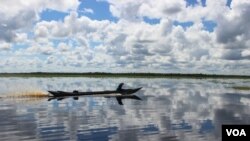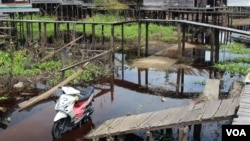Indonesian organizations are teaming up for the massive task of preventing forest and ground fires that blanket the region in haze every year during the dry season.
Last year, fires in the peatland forest of Sumatra and Kalimantan created an environmental crisis due to an extended drought and El Nino weather conditions.
In Palangkaraya, the Central Kalimantan capital, the haze was so bad schools and businesses closed and thousands suffered respiratory and eye problems.
Now, a team funded by the government’s Indonesia Climate Change Trust Fund is working with local communities in Kalimantan, Indonesia’s part of Borneo Island, on how to tackle the problem and benefit from preserving local forests.
Seeking attention
“We want to open up knowledge to local people and especially for the world to open their eyes and understand that we need this kind of research on peatland areas,” said Siti Maimunah, head of faculty for the agriculture and forestry department at the University of Muhammadiyah at Palangkaraya, which is leading the effort.
One major goal of the government-funded project is to persuade local villages to let them block canals that have drained peat forests for years, creating an imbalance in the water table that has left the area vulnerable to fires and flooding.
“Once you remove water from the system, then the peat soils, which are made up of non-decomposed organic material, dry out, and so they can start to oxidize... or they can become at high risk of fire,” said Jeffrey Chatellier, the country director for Indonesian environmental consultant Forest Carbon. “Once the fires start, it’s very hard to put them out.”
The fires are largely the product of land-clearing practices on drained peatland to create more area for oil palms. But peat soil can burn meters underground, further complicating efforts to battle fires.
Modern technology
The initial phase of this project uses drones to survey forests. Mapping with drones allows the team to assess forest health and devise planting and patrol systems. The view they provide of canals provides information that can be used to plan a hydrology management system.
Chatellier said drones provide a cost-effective way of surveying remote forest areas.
“The high-resolution drone imagery provides a very detailed look into forest conditions, allowing for the development of appropriate conservation activities that will reduce risk of fire and rehabilitate the forest,” he said.
Once the team understands the situation, it can start taking action to remedy it.
Local consequences
The project centers on a concession managed by PT Hutan Amanah Lestari (PT HAL), a forest restoration company, and another partner. Its 25,000-hectare concession is surrounded by land that has been flooded over the years.
In the flooded swamps, abandoned bridges surrounded by water sit near solitary homes on stilts, whose residents wade up to their necks when not in their boats. The fires stripped the area of its trees, and with no roots to hold the soil in place or suck up water, swamps took over the landscape.
The problem started decades ago when the government tried to turn Kalimantan into a major crop-producing region, but the soil was not suited to mass agriculture and the project failed. But the canals remained, along with others dug over the years to help drain land for palm oil plantations or small farms and fishing ponds.
The scale of the task is daunting. But the use of modern technology may offer much speedier solutions than were possible just a few years ago.







